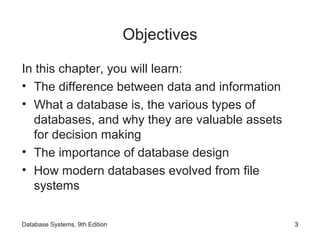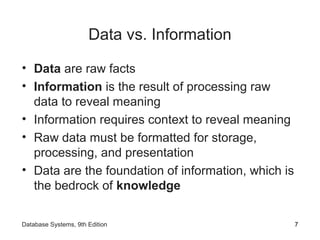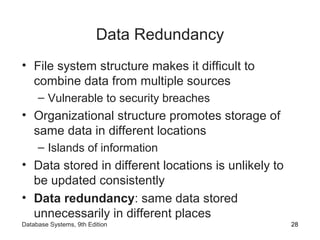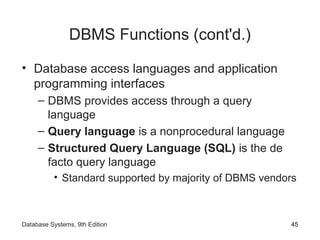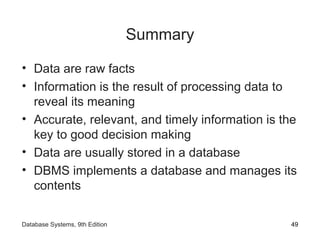Fundamentals of Database ppt ch01
- 1. About the Presentations • The presentations cover the objectives found in the opening of each chapter. • All chapter objectives are listed in the beginning of each presentation. • You may customize the presentations to fit your class needs. • Some figures from the chapters are included. A complete set of images from the book can be found on the Instructor Resources disc.
- 2. Database Systems: Design, Implementation, and Management Ninth Edition Chapter 1 Database Systems
- 3. Objectives In this chapter, you will learn: • The difference between data and information • What a database is, the various types of databases, and why they are valuable assets for decision making • The importance of database design • How modern databases evolved from file systems 3Database Systems, 9th Edition
- 4. Objectives (cont’d.) • About flaws in file system data management • The main components of the database system • The main functions of a database management system (DBMS) 4Database Systems, 9th Edition
- 5. Introduction • Good decisions require good information derived from raw facts • Data is managed most efficiently when stored in a database • Databases evolved from computer file systems • Understanding file system characteristics is important 5Database Systems, 9th Edition
- 6. Why Databases? • Databases solve many of the problems encountered in data management – Used in almost all modern settings involving data management: • Business • Research • Administration • Important to understand how databases work and interact with other applications 6Database Systems, 9th Edition
- 7. Data vs. Information • Data are raw facts • Information is the result of processing raw data to reveal meaning • Information requires context to reveal meaning • Raw data must be formatted for storage, processing, and presentation • Data are the foundation of information, which is the bedrock of knowledge 7Database Systems, 9th Edition
- 8. Data vs. Information (cont’d.) • Data: building blocks of information • Information produced by processing data • Information used to reveal meaning in data • Accurate, relevant, timely information is the key to good decision making • Good decision making is the key to organizational survival 8Database Systems, 9th Edition
- 9. Introducing the Database • Database: shared, integrated computer structure that stores a collection of: – End-user data: raw facts of interest to end user – Metadata: data about data • Provides description of data characteristics and relationships in data • Complements and expands value of data • Database management system (DBMS): collection of programs – Manages structure and controls access to data 9Database Systems, 9th Edition
- 10. Role and Advantages of the DBMS • DBMS is the intermediary between the user and the database – Database structure stored as file collection – Can only access files through the DBMS • DBMS enables data to be shared • DBMS integrates many users’ views of the data 10Database Systems, 9th Edition
- 11. 11Database Systems, 9th Edition
- 12. Role and Advantages of the DBMS (cont’d.) • Advantages of a DBMS: – Improved data sharing – Improved data security – Better data integration – Minimized data inconsistency – Improved data access – Improved decision making – Increased end-user productivity 12Database Systems, 9th Edition
- 13. Types of Databases • Databases can be classified according to: – Number of users – Database location(s) – Expected type and extent of use • Single-user database supports only one user at a time – Desktop database: single-user; runs on PC • Multiuser database supports multiple users at the same time – Workgroup and enterprise databases 13Database Systems, 9th Edition
- 14. Types of Databases (cont’d.) • Centralized database: data located at a single site • Distributed database: data distributed across several different sites • Operational database: supports a company’s day-to-day operations – Transactional or production database • Data warehouse: stores data used for tactical or strategic decisions 14Database Systems, 9th Edition
- 15. Types of Databases (cont'd.) • Unstructured data exist in their original state • Structured data result from formatting – Structure applied based on type of processing to be performed • Semistructured data have been processed to some extent • Extensible Markup Language (XML) represents data elements in textual format – XML database supports semistructured XML data 15Database Systems, 9th Edition
- 16. 16Database Systems, 9th Edition
- 17. Why Database Design Is Important • Database design focuses on design of database structure used for end-user data – Designer must identify database’s expected use • Well-designed database: – Facilitates data management – Generates accurate and valuable information • Poorly designed database: – Causes difficult-to-trace errors 17Database Systems, 9th Edition
- 18. Evolution of File System Data Processing • Reasons for studying file systems: – Complexity of database design is easier to understand – Understanding file system problems helps to avoid problems with DBMS systems – Knowledge of file system is useful for converting file system to database system • File systems typically composed of collection of file folders, each tagged and kept in cabinet – Organized by expected use 18Database Systems, 9th Edition
- 19. Evolution of File System Data Processing (cont'd.) • Contents of each file folder are logically related • Manual systems – Served as a data repository for small data collections – Cumbersome for large collections • Computerized file systems – Data processing (DP) specialist converted computer file structure from manual system • Wrote software that managed the data • Designed the application programs 19Database Systems, 9th Edition
- 20. Evolution of File System Data Processing (cont'd.) • Initially, computer file systems resembled manual systems • As number of files increased, file systems evolved – Each file used its own application program to store, retrieve, and modify data – Each file was owned by individual or department that commissioned its creation 20Database Systems, 9th Edition
- 21. 21Database Systems, 9th Edition
- 22. 22Database Systems, 9th Edition
- 23. 23Database Systems, 9th Edition
- 24. Problems with File System Data Processing • File systems were an improvement over manual system – File systems used for more than two decades – Understanding the shortcomings of file systems aids in development of modern databases – Many problems not unique to file systems • Even simple file system retrieval task required extensive programming – Ad hoc queries impossible – Changing existing structure difficult 24Database Systems, 9th Edition
- 25. Problems with File System Data Processing (cont'd.) • Security features difficult to program – Often omitted in file system environments • Summary of file system limitations: – Requires extensive programming – Cannot perform ad hoc queries – System administration is complex and difficult – Difficult to make changes to existing structures – Security features are likely to be inadequate 25Database Systems, 9th Edition
- 26. Structural and Data Dependence • Structural dependence: access to a file is dependent on its own structure – All file system programs must be modified to conform to a new file structure • Structural independence: change file structure without affecting data access • Data dependence: data access changes when data storage characteristics change • Data independence: data storage characteristics do not affect data access 26Database Systems, 9th Edition
- 27. Structural and Data Dependence (cont'd.) • Practical significance of data dependence is difference between logical and physical format • Logical data format: how human views the data • Physical data format: how computer must work with data • Each program must contain: – Lines specifying opening of specific file type – Record specification – Field definitions 27Database Systems, 9th Edition
- 28. Data Redundancy • File system structure makes it difficult to combine data from multiple sources – Vulnerable to security breaches • Organizational structure promotes storage of same data in different locations – Islands of information • Data stored in different locations is unlikely to be updated consistently • Data redundancy: same data stored unnecessarily in different places 28Database Systems, 9th Edition
- 29. Data Redundancy (cont'd.) • Data inconsistency: different and conflicting versions of same data occur at different places • Data anomalies: abnormalities when all changes in redundant data are not made correctly – Update anomalies – Insertion anomalies – Deletion anomalies 29Database Systems, 9th Edition
- 30. Lack of Design and Data-Modeling Skills • Most users lack the skill to properly design databases, despite multiple personal productivity tools being available • Data-modeling skills are vital in the data design process • Good data modeling facilitates communication between the designer, user, and the developer 30Database Systems, 9th Edition
- 31. Database Systems • Database system consists of logically related data stored in a single logical data repository – May be physically distributed among multiple storage facilities – DBMS eliminates most of file system’s problems – Current generation stores data structures, relationships between structures, and access paths • Also defines, stores, and manages all access paths and components 31Database Systems, 9th Edition
- 32. 32Database Systems, 9th Edition
- 33. The Database System Environment • Database system: defines and regulates the collection, storage, management, use of data • Five major parts of a database system: – Hardware – Software – People – Procedures – Data 33Database Systems, 9th Edition
- 34. 34Database Systems, 9th Edition
- 35. The Database System Environment (cont'd.) • Hardware: all the system’s physical devices • Software: three types of software required: – Operating system software – DBMS software – Application programs and utility software 35Database Systems, 9th Edition
- 36. The Database System Environment (cont'd.) • People: all users of the database system – System and database administrators – Database designers – Systems analysts and programmers – End users • Procedures: instructions and rules that govern the design and use of the database system • Data: the collection of facts stored in the database 36Database Systems, 9th Edition
- 37. The Database System Environment (cont'd.) • Database systems are created and managed at different levels of complexity • Database solutions must be cost-effective as well as tactically and strategically effective • Database technology already in use affects selection of a database system 37Database Systems, 9th Edition
- 38. DBMS Functions • Most functions are transparent to end users – Can only be achieved through the DBMS • Data dictionary management – DBMS stores definitions of data elements and relationships (metadata) in a data dictionary – DBMS looks up required data component structures and relationships – Changes automatically recorded in the dictionary – DBMS provides data abstraction and removes structural and data dependency 38Database Systems, 9th Edition
- 39. 39Database Systems, 9th Edition
- 40. DBMS Functions (cont'd.) • Data storage management – DBMS creates and manages complex structures required for data storage – Also stores related data entry forms, screen definitions, report definitions, etc. – Performance tuning: activities that make the database perform more efficiently – DBMS stores the database in multiple physical data files 40Database Systems, 9th Edition
- 41. 41Database Systems, 9th Edition
- 42. DBMS Functions (cont'd.) • Data transformation and presentation – DBMS transforms data entered to conform to required data structures – DBMS transforms physically retrieved data to conform to user’s logical expectations • Security management – DBMS creates a security system that enforces user security and data privacy – Security rules determine which users can access the database, which items can be accessed, etc. 42Database Systems, 9th Edition
- 43. DBMS Functions (cont'd.) • Multiuser access control – DBMS uses sophisticated algorithms to ensure concurrent access does not affect integrity • Backup and recovery management – DBMS provides backup and data recovery to ensure data safety and integrity – Recovery management deals with recovery of database after a failure • Critical to preserving database’s integrity 43Database Systems, 9th Edition
- 44. DBMS Functions (cont'd.) • Data integrity management – DBMS promotes and enforces integrity rules • Minimizes redundancy • Maximizes consistency – Data relationships stored in data dictionary used to enforce data integrity – Integrity is especially important in transaction- oriented database systems 44Database Systems, 9th Edition
- 45. DBMS Functions (cont'd.) • Database access languages and application programming interfaces – DBMS provides access through a query language – Query language is a nonprocedural language – Structured Query Language (SQL) is the de facto query language • Standard supported by majority of DBMS vendors 45Database Systems, 9th Edition
- 46. DBMS Functions (cont'd.) • Database communication interfaces – Current DBMSs accept end-user requests via multiple different network environments – Communications accomplished in several ways: • End users generate answers to queries by filling in screen forms through Web browser • DBMS automatically publishes predefined reports on a Web site • DBMS connects to third-party systems to distribute information via e-mail 46Database Systems, 9th Edition
- 47. Managing the Database System: A Shift in Focus • Database system provides a framework in which strict procedures and standards enforced – Role of human changes from programming to managing organization’s resources • Database system enables more sophisticated use of the data • Data structures created within the database and their relationships determine effectiveness 47Database Systems, 9th Edition
- 48. Managing the Database System: A Shift in Focus (cont'd.) • Disadvantages of database systems: – Increased costs – Management complexity – Maintaining currency – Vendor dependence – Frequent upgrade/replacement cycles 48Database Systems, 9th Edition
- 49. Summary • Data are raw facts • Information is the result of processing data to reveal its meaning • Accurate, relevant, and timely information is the key to good decision making • Data are usually stored in a database • DBMS implements a database and manages its contents 49Database Systems, 9th Edition
- 50. Summary (cont'd.) • Metadata is data about data • Database design defines the database structure – Well-designed database facilitates data management and generates valuable information – Poorly designed database leads to bad decision making and organizational failure • Databases evolved from manual and computerized file systems 50Database Systems, 9th Edition
- 51. Summary (cont'd.) • In a file system, data stored in independent files – Each requires its own management program • Some limitations of file system data management: – Requires extensive programming – System administration is complex and difficult – Changing existing structures is difficult – Security features are likely inadequate – Independent files tend to contain redundant data • Structural and data dependency problems 51Database Systems, 9th Edition
- 52. Summary (cont'd.) • Database management systems were developed to address file system’s inherent weaknesses • DBMS present database to end user as single repository – Promotes data sharing – Eliminates islands of information • DBMS enforces data integrity, eliminates redundancy, and promotes security 52Database Systems, 9th Edition



